|
The
open-door policy: experimentation with dress
The death of Mao Zedong on 9 September 1976 ended an
era and led to the arrest of Mao's wife Jiang Qing and
other members of the Gang of Four who rose to
prominence during the Cultural Revolution.
The
open-door policy and economic reforms which followed,
created an environment in which people were receptive
to the outside world and eager to make up for the 10
lost years of the Cultural Revolution. Dress was
one of the first areas where attitudes were relaxed.
Women began to wear coloured and patterned clothing,
and accessories were emblazoned with English words such
as 'happy' or 'beautiful' rather than 'serve the people'.
Clothing which appeared foreign was perceived as modern.
The
1980s was a period of unprecedented experimentation
with dress style. China's first fashion magazine Shizhuang
(Fashion) was published in Peking in 1979. Since then
such magazines have become popular reflecting the huge
interest in personal appearance, beauty and consumer
culture.

Woman wearing body-hugging knitted
top, white gloves and sunglasses, early 1980s. |
Contemporary
fashion: mainland China
The contemporary fashion world in mainland China is
vast, complex and there are many players. Most garments
are produced by large state-run corporations and joint-venture
companies established with overseas capital. Much design
is therefore anonymous.
However,
a growing number of designers have established their
own labels and work independently. Many of them are
young and entrepreneurial with a clearly identified
market. They sell direct to customers or through up-market
department stores.
Government
agencies have played an active role in developing China's
fashion industry. The China Garment Designers' Association
has promoted the work of young designers since its inception
in 1993. It organises fashion events such as the Golden
Scissors Award for functional wear and the Japanese-sponsored
Brother Cup for fashion designers under 35 which emphasises
creativity over functionality. In 1996 the China Famous
Brand Name Development Company was established to spearhead
China's ambitions to create ten world-famous fashion
labels by the year 2000.
Designers
from mainland China
Sun Jian
Sun Jian (born 1967) taught fashion design for a number
of years before being appointed chief designer of Aidekang
(Ideal Couture Fashion Company Limited), a Beijing-based
Chinese-German joint-venture, in 1989. In 1992 after
working as chief designer for a number of other organisations
Sun Jian established her own company and label, Sun
Jian Fashion Studio. She has a growing clientele and
her designs are worn by many young actors, pop stars
and television personalities.
Sun
Jian also has a popular image design business,
advising clients on personal style, including hair,
make-up, clothing and accessories. Clients often order
two or three made-to-measure outfits. On average Sun
Jian re-styles eight women per week.
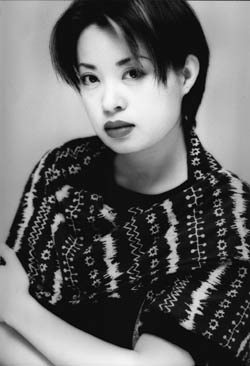
Sun Jian. Photo courtesy:
Duan Heping. |
|
|
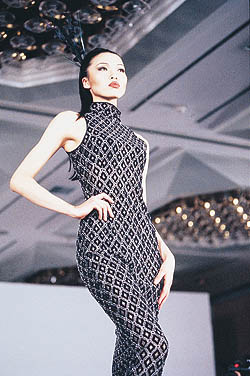
Tailored evening dress:
this cheungsam-inspired dress is
made from a nylon-cotton knit ornamented
with Austrian crystal diamantes. Photo by
Li Xiaomu. Courtesy: Overseas Chinese News.
These
ensembles were first paraded at Fashion
Week in Beijing in April 1996. They are
from a collection titled Approaching
1997.
Similar
ensembles are held in the Powerhouse Museum
collection. Gift of Sun Jian.
|
|
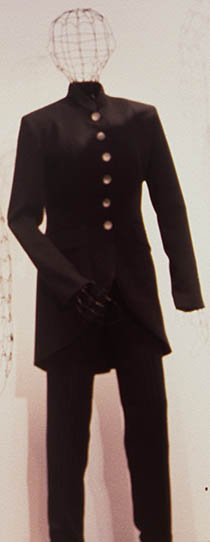
Trouser-suit:
comprises a jacket with Chinese stand collar. The
design of the jacket is inspired by an early form
of the Sun Yat-sen suit. Photo by Duan Heping. |
Guo
Pei
Guo Pei (born 1967) worked for a number of fashion companies
before becoming chief designer for the newly established
Tianma (Heavenly Horse) Clothing Company, Peking, in
1989, which quickly became one of China's most popular
womens labels. During Guo's six-year employment, 250
of her garments were produced, totalling some 400 000
items. In 1995 Guo Pei moved to the Milano Fashion Company
Limited, a Taiwanese-American joint venture. While working
with Milano, Guo Pei continued to design her own independent
collections. In 1996 she resigned and established her
own company Meiguifang (Mayflower) and in 1997 was named
one of China's top ten designers.

Guo Pei. Photo courtesy: Li Mingfang.
|
|

Woollen hipster shorts worn with
a long-sleeved woollen jumper. Photo by Li Xiaomu.
Courtesy: Overseas Chinese News.
|
|
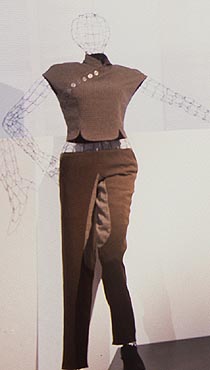
Green
hipster trousers: with a matching Chinese-style
side-fastening top. Guo Pei has modified the traditional
stand collar so that one side is turned down in
a Western manner. Photo by Penelope Clay. Powerhouse
Museum collection 2001/123/2
These
ensembles were first paraded at Fashion Week in
Peking in April 1996. They are from a collection
titled Approaching 1997, which also included
brightly coloured sensible suits for working women.
Similar ensembles are held in the collection of
the Powerhouse Museum. Gift of Guo Pei.
|
Mao's
new suit
Mao's new suit, is an Australian documentary
which charts the course of Peking fashion designers
Sun Jian and Guo Pei staging a show during Shanghai's
annual fashion week.
Both
designers were born during the Cultural Revolution -
a time when most women wore blue and grey trouser suits.
To look fashionable was a sign of spiritual corruption
and bourgeois tendencies. Today, armed with mobile phones
and ambitious humour, they are a symbol of modern China's
"to get rich is glorious" generation.
Contemporary fashion: Hong Kong
The Western-style tailoring for which Hong Kong is renowned
is linked to the territory's colonial past. British
merchants established the basis for a textile industry
soon after Hong Kong came under British rule in 1841.
The
Hong Kong Trade Development Council was formed in 1966
to promote exports. As clothing and textiles were the
major export, a core function of the council was to
promote Hong Kong as an international fashion centre.
By the 1970s it had become the manufacturing base for
Levi Strauss jeans and many other famous international
labels.
Today
Hong Kong designers promote their collections at the
biannual Hong Kong Fashion Week and at parades organised
by the Hong Kong Fashion Designers' Association. It
is through these high-fashion collections that designers
seek to position themselves on the world stage. With
the transition to Chinese sovereignty on 1 July 1997,
Hong Kong has maintained its role as an important fashion
centre. A number of designers used this historic event
as a source of inspiration for their collections.
Designers
from Hong Kong
Peter Lau
Peter Lau (born 1955) has worked in the fashion industry
for over 20 years. In the mid-1970s he worked for knitwear
and denim manufacturers and from 1975 to 1979 he studied
textile technology at the Hong Kong Polytechnic. Lau
established his own business in 1982 and in 1990 launched
a label for special occasion wear, XCVIII Ninety-Eight.
He has since launched a second label, China Doll, targeting
teenagers. His primary markets are in Hong Kong, Taiwan
and Japan.
Lau's
garments have a playful, often raunchy interpretation
of a Chinese folk aesthetic. Using vivid colours, patterns
and textures many of his garments play on fantasies
of the Oriental woman.
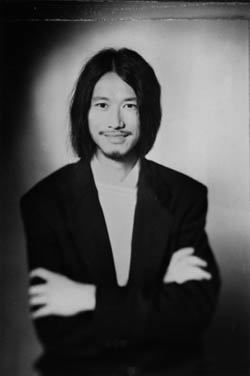
Peter Lau. Photo courtesy: Timothy
Leung. |
|
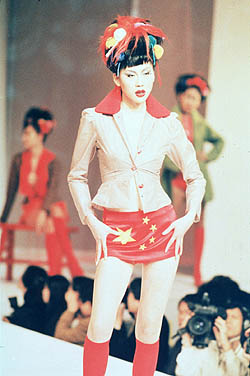
Neo-punk in China ensemble:
Comprising a paper nylon top with wool collar and
a polyester satin skirt, screenprinted with a yellow
star design evocative of the Chinese flag. Autumn-Winter
1996-97 collection. Photo by Anat Givon/AAP. 2002/21/1.
|
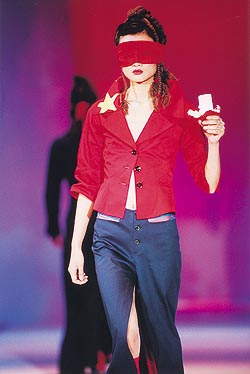
Winter under the Red Flag ensemble:
The cotton gaberdine trousers fasten at the inner
leg and crotch. Autumn-Winter 1997-98 collection.
Photo courtesy: Hong Kong Trade Development Council.
Similar ensembles are held in the Powerhouse Museum
collection. Gift of Peter Lau. |
William Tang
In addition to designing clothes, William Tang (born
1959) is also a television presenter and writes for
the press. He studied economics in Canada and fashion
design at the London College of Fashion before returning
to Hong Kong in 1982. He worked for a number of international
labels before establishing his own company in 1985.
Tang
has undertaken corporate-image and uniform design for
clients such as Dragon Air and the new Hong Kong airport.
His innovation and daring has earned him a reputation
as an enfant terrible of the Hong Kong fashion world.
Tang designs for men and women under the labels William
Tang, W by William and the new teenage unisex label
W10.

William Tang. Courtesy: William
Tang. |
|
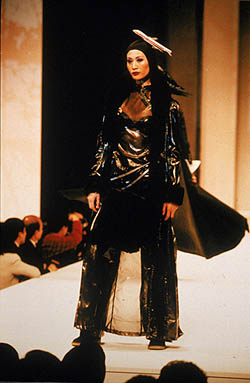
Womens
ensemble: Comprising a Chinese-style top, trousers,
and coat made of polyamide with fake fur shoulder
bag and gauze cap ornamented with a recycled plastic
toy aeroplane. Photo by Henry Ng. Courtesy: William
Tang.
Similar
ensembles are held in the Powerhouse Museum collection.
Gift of William Tang.
|
Contemporary
fashion: Taiwan
Since the 1970s individual designers have formed their
own companies and significantly raised the profile of
the local Taiwanese fashion industry. Lu Fong-chih and
Wang Chen Tsai-hsieh are two influential designers who
established their own labels in 1978 and 1982 respectively.
They are regarded as the first generation of
Taiwanese fashion designers.
In
recent years many young Taiwanese designers - some of
whom have returned from studying overseas - have sought
to create garments with an individual style. Some blend
elements of Eastern and Western dress traditions, which
is in part, a reaction to the prevalence and popularity
of Western designer labels in Taiwan.
The
Taiwan Taipei Fashion Designers' Association was formed
in 1990 to elevate the standard of fashion design and
increase international competitiveness in textiles and
clothing. In 1993 it sponsored the first of the biannual
Taipei Collection fashion shows, which have since become
a major showcase for local designers. These parades
include designer collections, young designer awards
and the Taiwan Textile Design Show, in which designers
work together with local textile manufacturers.
Carole
Chang
Carole Chang (Zhang Yiping) was born in 1969
and studied fashion in Lyon, France at the Ecole
Bellecour Supemod from 1990 to 1992. She established
her own label in Taiwan in 1995 for women of her age,
and soon after opened a boutique called Hot Ice.
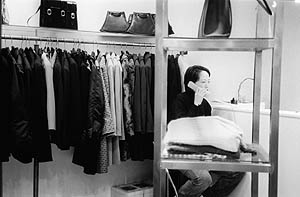
Carole Chang. Photo courtesy: Claire
Roberts. |
Chang's
designs are austere, even slightly masculine, emphasising
a long line rather than a curvaceous form. She believes
clothes should express the personality not create a
character. Chang is critical of many Taiwanese women
who hide behind international designer-label fashion,
but is nevertheless optimistic about the future of Taiwanese
fashion.

Cotton-drill jacket: Inspired
by military dress, the Sun Yat-sen suit in particular.
It is teamed with silk brocade trousers, black leather
shoes and spectacle frames which have battery-powered
side lights. Photo courtesy: Carole Chang. |

Purple
striped shirt: Made of raw silk, worn with woollen
trousers, a polyester satin overskirt and leather
shoes. These ensembles are from Chang's Autumn-Winter
1996-97 collection. Photo courtesy: Carole Chang.
Similar
ensembles are held in the collection of the Powerhouse
Museum. Gift of Carole Chang.
|
Stephane
Dou Teng-hwang
Stephane Dou Teng-hwang was born in 1969 and graduated
from fashion design school in Taiwan in 1991. He was
employed in the fashion industry for a number of years
before establishing his own label in 1996: Stephane
Dou.
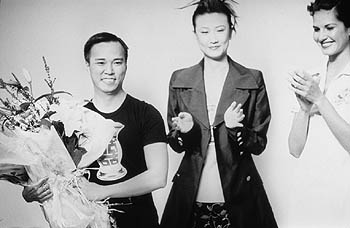
Photo of Stephane Dou Teng-hwang
and Chang Lee Yu-gin. Courtesy: Taiwan Textile Federation. |
He
has won a number of awards including the Taiwan Smirnoff
Fashion Award in the year of his graduation. On two
occasions he represented Taiwan in the International
Youth Fashion competition in Paris, and in 1995 he participated
in an exhibition of Taiwanese fashion at the Peking
International Fashion Fair. His contribution to the
Autumn-Winter '96-'97 Textile Design Show was the result
of collaboration with his partner, Chang Lee Yu-gin,
and the textile manufacturer Ta Ching Hwa Enterprise
Company.
|
Red
and hot-pink polyamide ensemble designed
by Stephane Dou Teng-hwang and Chang Lee
Yu-gin in association with Ta Ching Hwa
Enterprise Co Ltd, Taipei, Taipei collection
parade Autumn-Winter '96-'97. The theme
of Dou and Chang's parade was inspired by
the return of Hong Kong to Chinese rule
in 1997. Dress and wrap skirt (left) tunic
and pants (right): The striking colour,
layering and cut of these ensembles are
evocative of aspects of Chinese culture.
The designer's aim is to bring together
tradition and the avant-garde, East
and West. Photo by Mai Hsien-yun. Courtesy:
Taiwan Textile Federation.
Similar
ensembles are held in the collection of
the Powerhouse Museum. Gift of Stephane
Dou Teng-hwang.
|
|
|